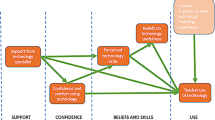Abstract
The objective of this study was to gather comprehensive information about the accessibility, use, and perceived needs toward computing technologies of elementary and secondary school teachers of science in two large rural school districts in the southeastern United States. Two instruments (one for elementary teachers and one for secondary teachers) containing over five hundred items were designed and administered to elementary and secondary teachers of science. One-hundred and twenty-two elementary teachers and twenty-two secondary teachers of science responded (a 71% return rate). Data were analyzed and grouped in eight categories: computer use and skill level; perceptions of current and needed hardware conditions; computer training and staff development; non-instructional uses of computers; instructional uses of computers; teachers' belifes about the instructional uses of computers; teachers' beliefs about computer use in their classroom; and current and future computer support needs. A descriptive data analysis indicated significant differences in many areas between elementary and secondary, teachers' responses. One strong implication from this study is to support the call for staff development in pre-service and in-service rural K-12 science education on the use of computing technologies.
Similar content being viewed by others
References
Abdel-Gaid, S., Trueblood, C. R., and Shrigley, R. L. (1986). A systematic procedure for constructing a valid microcomputer attitude scale.Journal of Research in Science Teaching 23(9):823–839.
Americna Association for the Advancement of Science, (1993).Benchmarks for Science Literacy Oxford University Press, New York.
Barker, B. (1986). The role of the microcomputer in rural schools.Rural Educator 8(1):1–3.
Baird, W. E., Rowsey, R. E., Easterday, K., and Smith, T. (1989). A comparison of secondary science and mathematics teachers: demographics and perceived needs. Department of Curriculum and Teaching, auburn University, Auburn, Alabama.
Bear, G. G., Richards, H. C., and Lancaster, P. (1987). Attitudes toward computers: validation of a computer attitudes scale.Journal of educational Computing Research 3(2):207–218.
Becker, H. J. (1986). Instructional uses of school computers.Report from the 1985 National Survey, The John Hopkins University, Issues 1–4.
Berdie, D. R., Anderson, J. R., and Niebuhr, M. A. (1986).Questionnaire: Design and Use, 2nd Ed., Scarecrow Press, Metuchen, New Jersey.
Bigham, S. (1994).An Analysis of Microcomputer Use Among Tennessee Science Teachers. Paper presented at the annual meeting of the Midsouth Educational Research Association, New Orleans, LA.
Bitter, G. G., and Davis, S. J. (1985). Measuring the development of computer literacy among teachers.AEDS Journal, 18:243–253.
Charron, E. H. (1991). Toward a social-contexts frame of reference for science education research.Journal of Research in Science Teaching, 28(7):619–629.
Collins, A. (1991). The role of computer technology in restructuring schools.Phi Delta Kappan 73, 28–36.
di Sessa, A. (1987). The third revolution in computers and education.Journal of Research in Science Teaching 24(4):343–367.
Dupagne, M. (1992). Teachers' attitude toward computers: A review of the literature.Journal of Research on Computing Education 24(3):420–429.
Educational Activities, Inc. (1983).Learning Styles Inventory. Freeport, New York.
Helgeson, S., and Kumar, D. (1993). A review of educational technology in science assessment.Journal of Computers in Mathematics and science Teaching 21(3–4):227–243.
Kathwohl, D. R. (1985).Social and Behvioral Science Research. Josey-Bass, San Francisco.
Kinnear, J. (1982).Birdbreed. Edutech, Rochester, New York.
Krynowsky, B. A. (1985). The development of the attitude toward the subject scale. Report No. 85:7. ERIC Document, RIEAPR86.
Lehman, J. R. (1995). Microcomputers and the preparation of secondary science teachers: an eight year follow-up.School Science and Mathematics 95(2), 69–77.
Lunetta, V. N. (1984).School Transactions. Conduit, The University of Iowa, Iowa City, Iowa.
McGinnis, J. R. (1995).So You Want to use a Class LISTSERV in Your Science Methods Class: Insights Shared on Nurturing along a Virtual Community Outside, the Graduate Science Methods Classroom. Paper presented at the Annual Meeting of the Association for the Education of Teachers of Science January. Charleston, West Virginia.
McGinnis, J. R. (1996). Promoting an electronic community with the use of communication technology in a graduate elementary science methods class.Journal of Elementary Science Education, 8(1) 39–63.
Menis, Y. (1984). Improvement in student attitudes and development of scientific curiosity by means of computer studies.Educational Technologies, 24:31–32.
National Resource Council (1996).National Science Education Standards. National Academy Press: Washington, D.C.
National Science Teachers Association (1988). Standards for the Preparation and Certification of Teachers of Science, K-12.NSTA Handbook. National Science Teachers Association. Washington, D.C., 75–185.
Schmid, J. (1990). Survey of computer use in Missouri social science classrooms reveals problems and promise.T.H.E. Journal: 86–89.
Smith, M. L., and Glass, G. V. (1987).Research and Evaluation in Education and the Social Scinces. Prentice-Hall, Inc., New Jersey, pp. 225–251.
Tobin, K., and Dawson, G. (1992). Constraints to curriculum reform: Teachers and the myths of schooling.Educational Teachnology, Research and Development 40(1):81–82.
Vermette, S. M., Orr, R. R., and Hall, M. H. (1986). Attitudes of elementary school students and teachers toward computers in education.Educational Technology, pp. 41–47.
Wepner, S. (1986). Educational computing in New Jersey: A status report. ERIC Document, RIEOCT86.
Wilburg, K. (1994). Teaching science with technology: Telecommunications and multimedia.Computing Teacher 21(7), 6–8.
Withey, S., and Jaeger, R. M. (1985). Study guide for survey research methods in education. In Jaeger, R. M. (Ed.),Alternative Methodologies in Educational Research. American Educational Research Association.
Author information
Authors and Affiliations
Rights and permissions
About this article
Cite this article
McGinnis, J.R., Simmons, P., Atwater, M.M. et al. Beliefs and perceived needs of rural K-12 teachers of science toward the uses of computing technologies. J Sci Educ Technol 5, 111–120 (1996). https://doi.org/10.1007/BF01575151
Issue Date:
DOI: https://doi.org/10.1007/BF01575151




